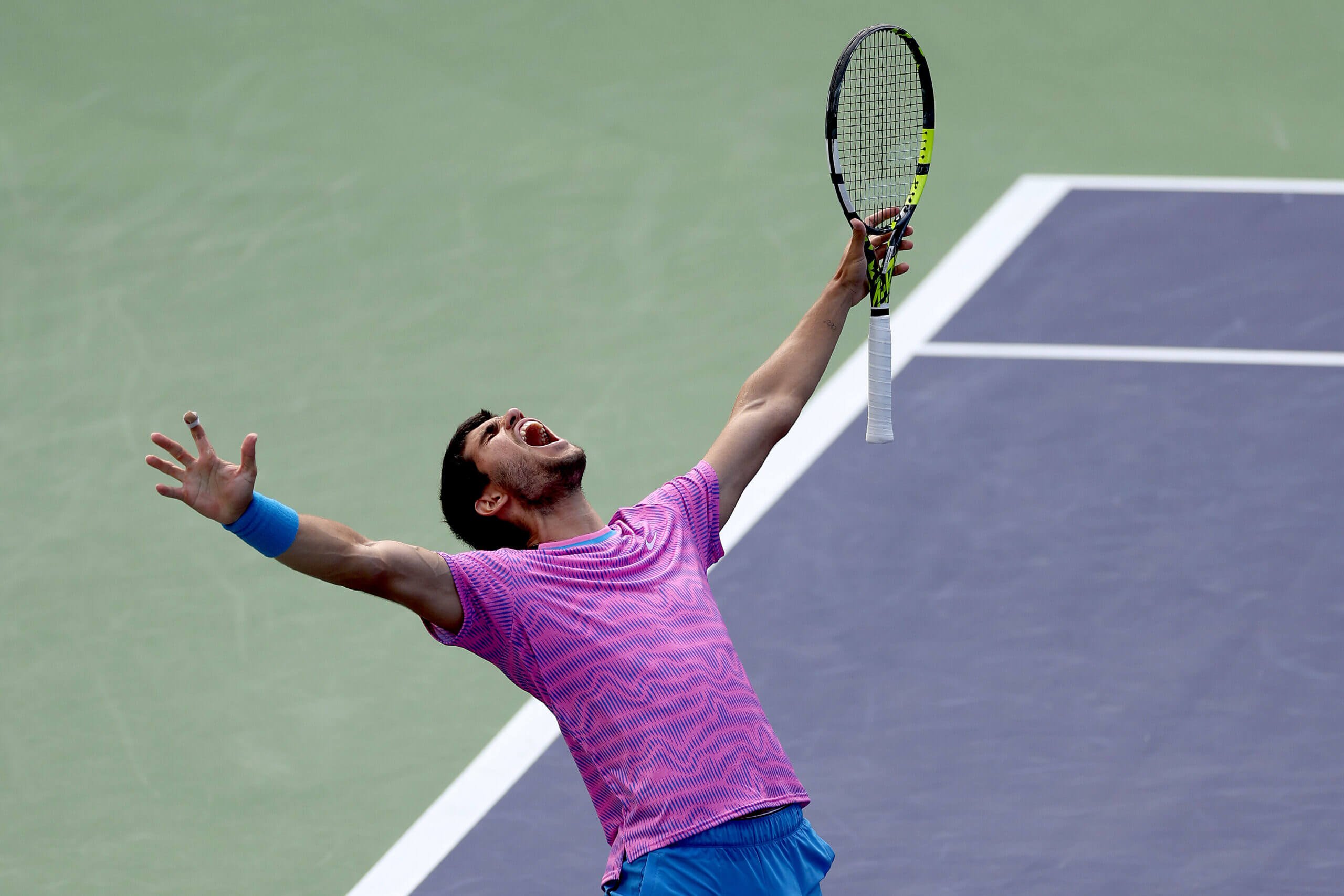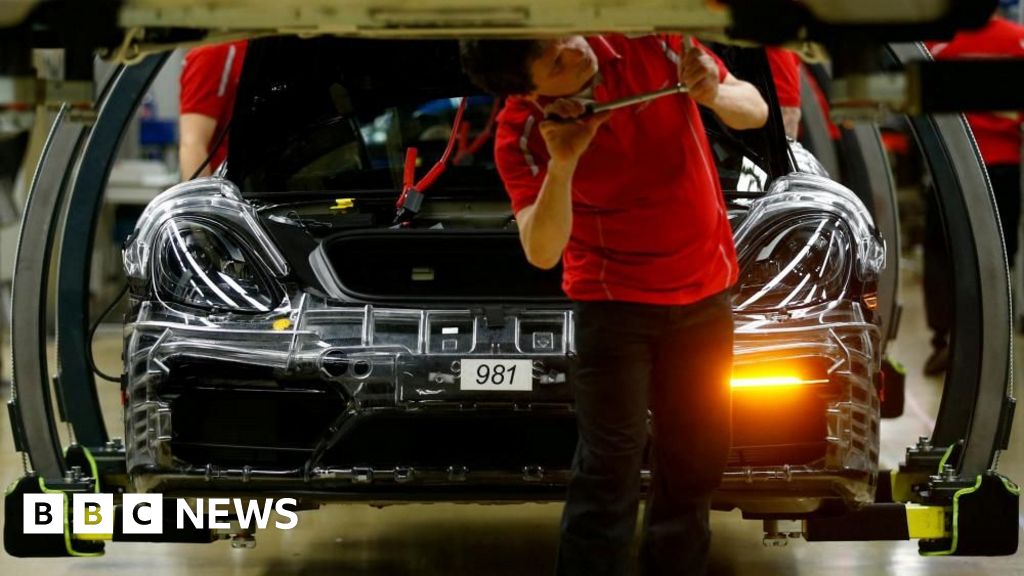
Carlos Alcaraz is making magic again. Watch out.
- Sports
- March 18, 2024
- No Comment
- 124
It happens every time that guy Carlos Alcaraz takes the court. One outrageously zany point where he does something that people who have been watching tennis for decades will swear on the life of their favorite doubles partner that they have never seen before.
And they are probably right because even as he muddled (for him) his way through the past six months or so, experiencing some version of a sophomore slump, Alcaraz has never failed to produce the spectacular.
On Sunday, in the final of the BNP Paribas Open in Indian Wells, the moment arrived a little more than halfway through the first set against Daniil Medvedev.
A perfectly lofted short-range lob came at Alcaraz as he closed in on the net. At first, he thinks he can leap backwards and smack it — but halfway into that maneuver, he realizes he has to turn and spring and chase it down, which he does, just before it settles onto the purple hard court for a second time.



And that’s when the Alcaraz-of-it-all really takes hold. At the final moment, he realizes that because of the way he’s holding his racket in his forehand grip, he can’t get under the ball. At this point, pretty much everyone else who has ever done this for a living takes a desperate swat and the ball skitters across the ground into the net. Not so with Alcaraz.
In a split second, he does this tiny wrist rotation and swipes at the ball with what in this moment is the backside of his strings.




And the point goes on and a few shots later, he cracks a forehand down the line and Medvedev watches it whistle by.

And just like that, tennis was on its way back to where it was last summer, with Alcaraz staking his claim to the game’s present and future, leaving an opponent heaving on every stroke, clinching a title while watching a last error float off the court, then hugging his tennis father and coach, Juan Carlos Ferrero, and his real father as thousands of fans bathe him in their roars of adulation.
Hours later, with a big glass trophy sitting next to him after his 7-6(5), 6-1 triumph, Alcaraz was at a loss to explain just what had happened on that little first miracle of a point.
“Something happened to my feet that I couldn’t jump,” he said. “When something like that happens, you have to put one more ball in and just run to the next one.”
Alcaraz has said repeatedly in the last two weeks that he’s had a rough time the past few months. The losing was weird, sure, but the main problem was when he stepped onto the court, whether it was to train or compete, he struggled to find the joy that he had always felt when he had a racket in his hand. His family and his coaches kept asking him what was wrong.
He had no answers for them, which, in some ways, made it worse. When he sprained his ankle in Rio last month, he was as low as he had been since the start of his career.

(Buda Mendes/Getty Images)
For nearly 200 years and probably longer than that, people have come to California for a restart, to relaunch their identity or to try to find their old, true one. And that is about what happened to Alcaraz over the past two weeks in the Coachella Valley.
The boy came back, and when he did, the show took off once more and never more so than in those crazy moments of sprinting, wrist-flicking and passing up the line in the first set that sent the capacity crowd of 16,000 into its first frenzy.
“Points like this one give me extra motivation to put a smile on my face,” he said — with a smile on his face.
This was going to happen before too long. Alcaraz is simply too gifted and too dedicated to the sport to let this eight-month drought without a title go on much longer. Why would the arc of his early career be any different from that point?
At the moment the first whispers of doubt were starting, when his close friend and rival Jannik Sinner was making his play for supremacy, Alcaraz surged to life. He beat Sinner in the semifinals here, ending the Italian’s 19-match winning streak, then got some revenge against Medvedev, who had ended his attempt to defend his title at the U.S. Open in September when this fallow period was just getting started.
Alcaraz is nothing if not resilient, especially when an A-list crowd is on hand, as it was on Sunday in the desert. Rod Laver was there, and Maria Sharapova, and the actors Charlize Theron, Zendaya and Tom Holland. When Alcaraz is on the court, especially in a final, a tennis match evolves into a happening and for the first couple of years, he almost always delivered. When that stopped happening during the past eight months, something felt slightly off with the tennis universe.
No more. The win gave Alcaraz his second consecutive title in what plenty of players and much of the sport consider the most important tournament that is not a Grand Slam. It was the 13th title of a career that is just getting going, even if the next time he claims the sport’s top ranking (it will happen soon enough) it will be his second go at No 1. In 2022, at 19, he became the youngest player ever to get to the top of the rankings.

(Matthew Stockman/Getty Images)
When it was over, Medvedev sat with his coach, Gilles Cervara, in the locker room, told him he had no regrets about the afternoon, and asked Cervara if he did. A shot or two here and there, Cervara said, but this one was on Alcaraz’s racket.
Medvedev said that when Alcaraz raised his level in the first set, he “kind of managed to be there and to try to catch his level, but I was just a little bit down. In the end, this down was going down, down, down, and he was going up, up, up”.
Alcaraz wasn’t alone in setting the world back into order on Sunday. In the women’s final, Iga Swiatek beat Maria Sakkari to win her second Indian Wells title in three years. Swiatek won 6-4, 6-0, taking out Greece’s most successful female player with a crisp efficiency that has become her trademark. And Swiatek being Swiatek, the win came with at least one set of pure domination – a second set ‘bagel’ in the scoreline that so often adds an exclamation point to so many of her victories.
Swiatek, 22, already the winner of four Grand Slams but none since June, showed her resilience last fall after she lost the No 1 ranking she had held for 76 weeks. By the season’s end, she had it back, but she stumbled early at the Australian Open, and with Aryna Sabalenka hitting her stride, Swiatek’s supremacy looked under threat. There were more reasons for jitters when things got started for her at Indian Wells 10 days ago.
She opened against Danielle Collins, who had nearly beaten her in Australia. After that came Linda Noskova, the young Czech who sent her home in Melbourne. Collins got three games. Noskova got four. Both endured a second-set bagel.
When Swiatek won here two years ago and then completed the ‘Sunshine Double’ two weeks later with a win at the Miami Open, it was a breakthrough moment for her. A master of clay court tennis, she had suddenly proven to herself that she could win on the hard court.
“This time, I’m just super happy with the work,” Swiatek said.
Her opponents, not so much. They know she has turned her dominance and efficiency into a strategy that has translated into a 19-4 record in finals and six straight wins in the ultimate match because she has so much energy in her reserves.

(Robert Prange/Getty Images)
“I’ve played bigger hitters, but at the same time she takes away time from you,” Sakkari said. “It took me a couple of games to just get used to her timing.”
The scary thing for all the other women is that the sweet spot of Swiatek’s season, the clay court swing, is still three weeks away. In years past, stepping onto the red clay felt like coming home and she looked forward to it.
“Now it doesn’t really matter,” she said in a bit of a flex.
For Alcaraz, the flexes often come in the form of those little miracles that he manages more than anyone else. Medvedev, who can pull off a few of his own every so often, knows the effect they can have when you do manage one.
“You feel like, OK, you can do more and more, hit stronger, hit faster and be better,” he said.
And that’s what happened as the match moved to the second set and its seemingly inevitable conclusion. At moments, it felt like the balls coming off Alcaraz’s racket were defying the laws of physics and not losing any velocity from the moment they shot off his racket to when they were bouncing up to Medvedev’s eyes or flying past him.
Medvedev would pound the ball over and over and Alcaraz would send it back, unbothered.
“He makes one good shot, I’m in trouble and I lose the point,” Medvedev said. “It’s tough. Mentally it’s not easy to play against this.”

No one knows this better than Alcaraz. From 80 feet away, it’s not hard at all to see a foe’s shoulders sagging, his spirit breaking, his head shaking with amazement and helplessness.
And nothing quite helps matters, in one moment or over the long-term, like a little bit of magic thinking and hitting. That wild series of shots when the tension was rising, it’s good for the game, both his and wider one, he said, and more importantly good for his soul.
“I always say that I’m playing better with a smile on my face,” he said. “Points like this one don’t matter if I win it or lose it, it puts a smile on my face anyway. I think it helps me to keep improving my game on the match and showing my best tennis.”
The smart money says Alcaraz’s best tennis is yet to come.
(Top photo: Matthew Stockman/Getty Images)
#Carlos #Alcaraz #making #magic #Watch








